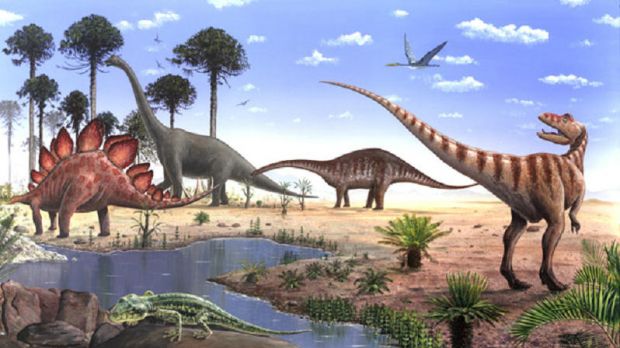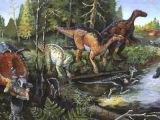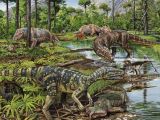Following the Paleozoic, when life started to get complex, the Mezozoic ("middle life", Secondary era) spanning from 250 to 65 Ma, was an era when reptiles were the rulers of the world. In fact, the dinosaurs were the real masters for over 150 million years.
1. Triassic (250-200 Ma) is named so because there are three specific stratigraphical layers coming from this era. Triassic was hot and dry, with no Ice Ages. Mountains were covered by gymnosperm forests, made of Cycadophita (species related to Cycas, a palm-like gymnosperm) and ancestors of the Angiosperms.
Many types of huge marine reptiles evolved now. Corals and ammonites (shelled squids) were abundant in the seas. The flora was dominated by gymnosperms and seed-ferns.
The reptiles got an evolutionary boom, diversifying continuously. Mammals, turtles, frogs, newts, crocodiles and the first dinosaurs appeared now. The dominant group were the mammalian reptiles (related to the ancestors of the mammals). Huge amphibians still inhabited the swamps. The first flying reptiles, pterosaurs, emerged in Triassic. Triassic ended with a mass extinction inside many groups of animals.
2. Jurassic (200-145 Ma) takes its name from Jura mountains (Germany).
This is when Teleostei, the modern bony fish appeared (they form now most of the fish species, from trout to tuna).
Ichthyosaurs, dolphin-like reptiles, wandered the seas. They reached lengths up to 8 m (27 ft) and fed on fish and mollusks. The largest predatory reptiles of the sea were the plesiosaurs, up to 15 m (50 ft) long. They had flippers resembling those of the sea turtles, but long necks (up to 7 (23 ft) m long, adapted for catching fish) and small heads. The group called pliosaurs had short necks and crocodile-like heads.
The wet and warm clime caused the development of a lush vegetation supporting giant animals. The land fauna was dominated by the huge herbivorous dinosaurs named sauropods, the largest beasts that ever roamed the Earth (the typical long-necked, long-tailed, small-headed, elephant-footed dinosaurs). Huge carnivorous dinosaurs preyed on them. Other herbivorous dinosaurs of the Jurassic are the stegosaurs (plated dinosaurs), famous for their back plates and the huge thorns on the tip of the tail. Birds appeared in this period, from carnivorous dinosaurs. The oldest bird fossil is Archeaopteryx, which lived 150 Ma ago.
3. Cretaceous (145-65 Ma), the "chalk era", owes its name to the huge chalk deposits formed in this period. It was wetter but cooler than the Jurassic period. The continents started to split towards their current configuration. The clime turned drier, and many forests were replaced by grasslands. This was the peak of the dinosaur evolution.
Angiosperms appeared and spread rapidly, co-evolving with the bees. Insects and fish were mainly the same as they are today. First marsupials and placentals were found. Birds were toothed. The skies were dominated by huge pterosaurs, with a wingspan of even 12 m (40 ft).
The more primitive herbivorous dinosaurs of the Jurassic had been replaced by the Iguanodons, horned dinosaurs (the most famous is Triceratops, 6 m (20 ft) long, having 2 m (6.6 ft) long horns), duck-billed dinosaurs and armored dinosaurs. These dinosaurs were adapted for life in the open. The carnivorous ones were highly diversified and evolved. The North America was dominated by the infamous T-rex.
At the end of the Cretaceous, a mass event wiped out the dinosaurs and most reptiles. 50% of the species and 25 % of the known families disappeared.

 14 DAY TRIAL //
14 DAY TRIAL // 

